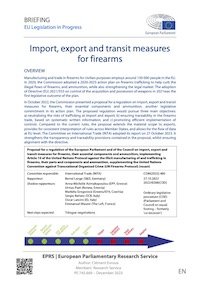By Everytown for Gun Safety
Deaths due to firearm violence occur in alarming numbers in the United States (U.S.) each year. In 2023, over 43,000 people died from a firearm-related injury, and the majority (55%) of these deaths were from suicide (Gun Violence Archive, 2024). Young people are at heightened risk, with firearms being the leading cause of death for youth ages 13-24, and the cause of half of all suicide deaths in this age group as well (Centers for Disease Control and Prevention, 2024; National Violent Death Reporting System, 2024). Only in the last five years did Congress allocate federal resources for firearm violence research, and the prior decades-long ban on this research has stymied information that could have been used to prevent these deaths (Hellman, 2019). This lack of research has had wide-reaching effects, including the limited understanding of how firearm violence impacts specific vulnerable populations, such as LGBTQ+ individuals. Although much progress has been made, systematic data collection efforts that assess LGBTQ+ identity and experiences have long been a challenge in the U.S., similarly limiting available research on LGBTQ+ health and wellness (Healthy People 2030, 2023). One of the most consistent findings we do know from available research, however, is that LGBTQ+ young people experience higher rates of considering and attempting suicide compared to their peers. The Trevor Project’s 2024 U.S. National Survey on the Mental Health of LGBTQ+ Young People found that 39% of all LGBTQ+ young people seriously considered attempting suicide in the past year. This finding is important in the context of what we know about firearms: they are the most lethal means used in suicide attempts; nearly 9 in 10 (89.6%) suicide attempts with a firearm result in death (Conner, Azrael, & Miller, 2019). Furthermore, though mass shootings constitute a small fraction (1.5%) of firearm deaths in the U.S., the public nature of this violence, often targeted toward members of oppressed groups, still have noteworthy impact. Mass shootings are defined by The Federal Bureau of Investigation (FBI) as any incident in which four or more people are shot and wounded or killed, excluding the shooter. Many LGBTQ+ people across the country identified with the victims of two widely publicized mass shootings that occurred at LGBTQ+ nightclubs in recent years: the Pulse shooting in 2016, and the shooting at Club Q in 2022. The mental health of survivors and directly impacted geographic communities are adversely affected by mass shootings (Lowe & Galea, 2017), and individuals not directly affected by mass shooting events can also experience post-traumatic stress through media exposure (Thompson et al., 2019). In the instance of the Pulse shooting, those who identified as LGBTQ+ responded more strongly to media coverage and, in turn, experienced more post-traumatic stress (First et al., 2023). Everytown for Gun Safety states that not only is addressing firearms essential to any strategy to reduce suicide, but also that the effect of mass shootings extends to survivors, families, and communities. Despite the elevated risk of suicide attempts among LGBTQ+ young people, the fact that the majority of firearm deaths in the U.S. are suicides, and the high lethality of suicide attempts involving firearms, little is known about how many LGBTQ+ young people own or have access to firearms, or how experiences of mass shooting events impact suicide risk. Using data from the 2024 U.S. National Survey on the Mental Health of LGBTQ+ Young people, this brief examines relationships between access to firearms, the impact of mass shootings, and suicide risk among LGBTQ+ young people. Results Access to Firearms Overall, 40% of LGBTQ+ young people reported that there was a firearm in their home. The majority (92%) of those with a firearm in the home reported that it was not theirs. Additionally, of those who reported the presence of a firearm in their home, 63% reported that the firearm was kept in a locked place, 22% reported that it was not kept in a locked place, and 15% reported that they did not know whether it was kept in a locked place. Demographics LGBTQ+ young people ages 13-17 reported higher rates of having a firearm in their home (44%), compared to their LGBTQ+ young people ages 18-24 (36%). LGBTQ+ young people living in the South reported the highest rates of having a firearm in their home (48%), followed by LGBTQ+ young people living in the Midwest (43%), West (37%), and Northeast (25%). Cisgender boys and men reported the highest rates of living in a home with a firearm (46%), followed by transgender girls and women (43%), transgender boys and men (42%), nonbinary youth (38%), youth questioning their gender identity (38%), and cisgender girls and women (36%). Native and Indigenous LGBTQ+ young people reported the highest rates of living in a home with a firearm (58%), followed by White LGBTQ+ young people (45%), Multiracial LGBTQ+ young people (38%), Black LGBTQ+ young people (31%), Latinx LGBTQ+ young people (29%), Middle Eastern and North African LGBTQ+ young people (22%), and Asian American and Pacific Islander LGBTQ+ young people (21%). No significant differences were found in rates of having a firearm in the home when comparing LGBTQ+ youth based on their socioeconomic status LGBTQ+ young people who reported the presence of a firearm in their home reported higher rates of having seriously considered suicide in the past year (43%), compared to their LGBTQ+ peers who did not report a firearm in their home (37%). Reporting the presence of a firearm in the home was associated with 19% higher odds of seriously considering suicide in the past year (adjusted odds ratio [aOR] = 1.19, 95% Confidence Interval [CI] = 1.11-1.28, p < 0.001), compared to LGBTQ+ young people who did not report the presence of a firearm in the home. LGBTQ+ young people who reported having a firearm in their home had higher rates of attempting suicide in the past year (13%), compared to their LGBTQ+ peers who did not report having a firearm in their home (11%). The presence of a firearm in the home was associated with 17% higher odds of reporting a suicide attempt in the past year (aOR = 1.17, 95% CI = 1.05-1.30, p < 0.01), Among LGBTQ+ young people who reported having a firearm in their home, 48% of those who did not keep it in a locked place and 46% of those who did not know if it was kept in a locked place seriously considered suicide in the last year, compared to the 40% who said the firearms were kept in a locked place (p<.001). Similarly, among those LGBTQ+ young people who reported the presence of a firearm in their home, 14% of those who did not keep it in a locked place and 15% of those who did not know if it was kept in a locked place attempted suicide in the last year, compared to the 12% who said the firearms were kept in a locked place (p<.001).
New York: Everytown for Gun Safety, 2024. 11p.















